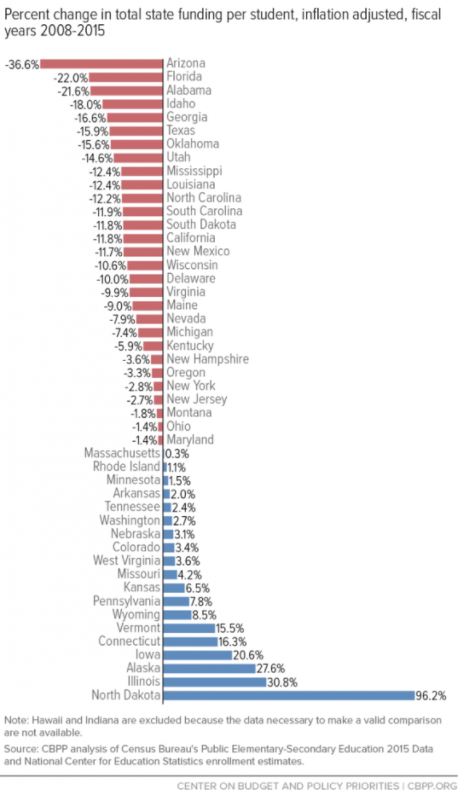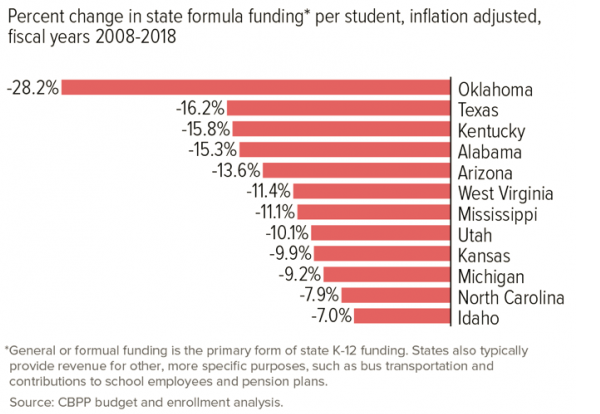A “Punishing Decade” for K-12 Education Funding in the States
Despite recent signs of gradually increasing spending on schools, many states today are devoting significantly less money to K-12 education that they were nearly a decade ago.
That’s the conclusion of a new analysis by the Center on Budget and Policy Priorities, which finds that in 29 states, total state funding per student on K-12 education—when adjusted for inflation—remains lower than it was during the 2007-08 school year, before the “Great Recession” took hold.
The center’s report, “A Punishing Decade for School Funding,” also found that in 17 states, the percentage drop in total state funding per student was 10 percent or more.
Arizona had the biggest decrease in state funding for K-12, at 36.6 percent; followed by Florida, down by 22 percent; Alabama, 21.6 percent; Idaho, 18 percent; Georgia, nearly 16.6 percent, Texas, 15.9 percent; Oklahoma, 15.6; Utah, 14.6 percent; Mississippi, 12.4 percent, and Louisiana, 12.4. The full state-by-state breakdown is shown below:

The center’s analysis also examined combined state and local funding for K-12 education, and found a similar picture.
Twenty-nine states also decreased state and local education funding between the 2007-08 and 2014-15 school years. Florida had the biggest cut in state and local K-12 funding during this period, a 25 percent drop, followed by Arizona, at 24.6 percent.
So why has states’ spending on K-12 fallen so sharply?
During and after the recession, many states cut K-12 funding, while leaving revenue sources—mostly taxes—unchanged, the Center on Budget and Policy Priorities concluded. In some cases, states dug themselves a deeper hole in education by cutting taxes, according to the center, a research organization that describes itself as devoted to reducing poverty and inequality, and supporting tax and budget policy that benefits low-income individuals.
For instance, between fiscal years 2008 an 2012, when the recession helped create major budget shortfalls, states closed 45 percent of those gaps by cutting spending and only 16 percent by raising taxes and fees. In addition, some states like Oklahoma and Texas have been hurt by declines in prices of oil and other natural resources. In other states, tax revenues have been weaker than anticipated.
In many of the states that have made the deepest cuts in education, “they’re really going to need to raise revenue if they’re going to re-invest in their schools,” said Michael Leachman, the director of state fiscal research at the Center on Budget and Policy Priorities, and one of the report’s authors.
Across the country, in many states the budget picture generally has been getting better over the past couple years, Leachman noted. (A report released recently by the National Association of State Budget Officers, for example, found that K-12 spending in the states rose over the past year, despite weak tax collections.) But there is a “group of states that we’re most concerned about.”
The center also looked at how much money states were providing through general formula funding—a primary source of funding in schools—this year, compared with the time before the recession took hold.
After adjusting for inflation, the researchers found that in 12 states, general funding plummeted between 2008 and 2018:

The data from the center emerges as many states, including Oklahoma, are locked in major battles over how much money to provide to schools, as my colleague who covers state policy for EdWeek, Daarel Burnette explains.
A bunch of states are also taking the unusual step of considering whether to scrap and replace their K-12 funding formulas—creating enormous uncertainty about how much funding will flow to schools.
See also:

But how much is spent per student, by state?